Leading and Managing Change: A Report on Leadership Styles and Skills
VerifiedAdded on 2022/11/30
|7
|1402
|51
Report
AI Summary
This report provides a comprehensive overview of various leadership styles and the essential skills required for effective management and leading change within organizations. It begins by defining leadership and its significance in influencing employee behavior towards common goals. The main body of the report delves into distinct leadership styles, including transactional, autocratic, charismatic, democratic, laissez-faire, and transformational approaches, highlighting their characteristics, strengths, and weaknesses. Furthermore, the report identifies key skills necessary for leaders, such as communication, motivation, positivity, delegation, and trustworthiness, emphasizing their importance in fostering a positive and productive work environment. The report concludes by summarizing the crucial role of leadership styles in shaping organizational culture and guiding the workforce toward achieving common objectives. References to relevant books and journals are included to support the analysis.
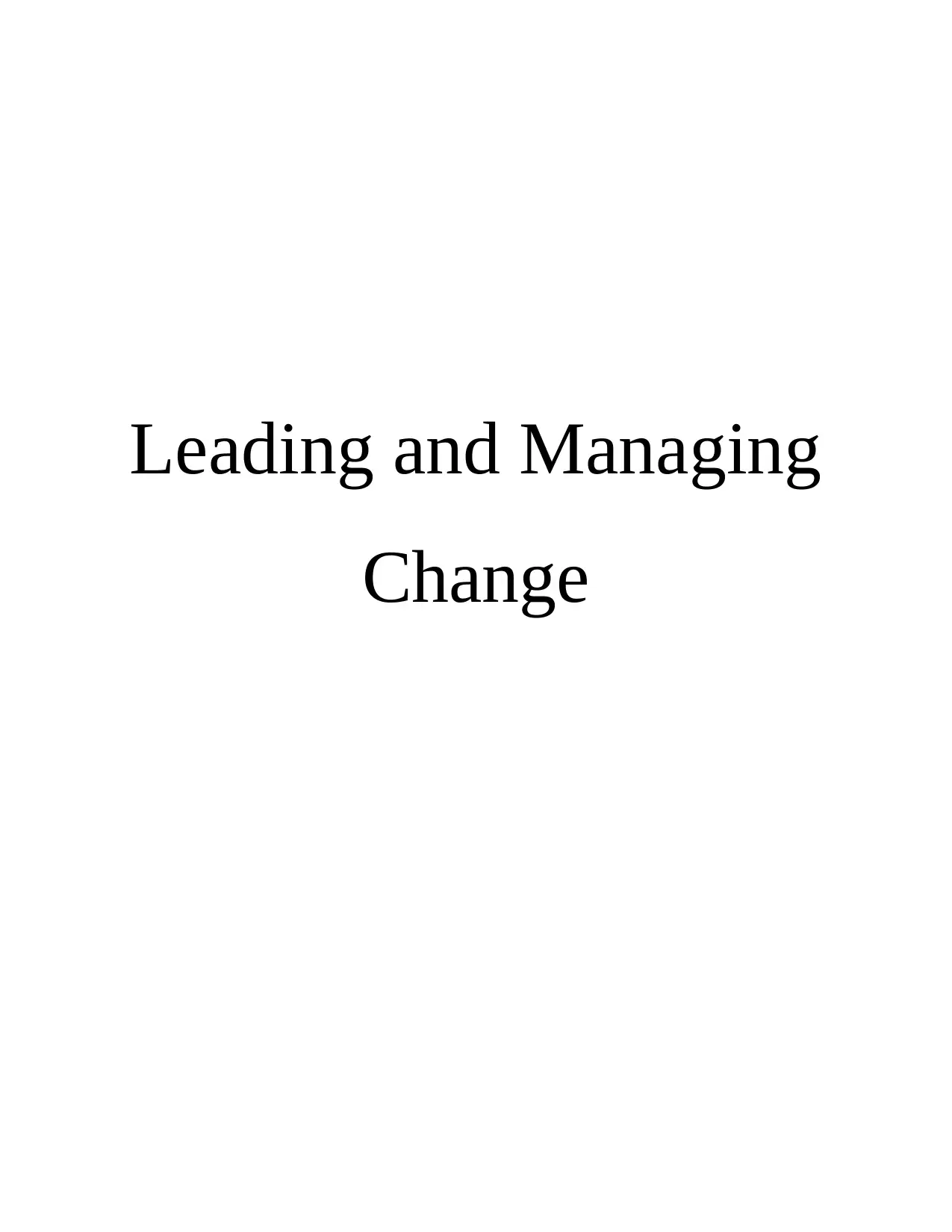
Leading and Managing
Change
Change
Paraphrase This Document
Need a fresh take? Get an instant paraphrase of this document with our AI Paraphraser
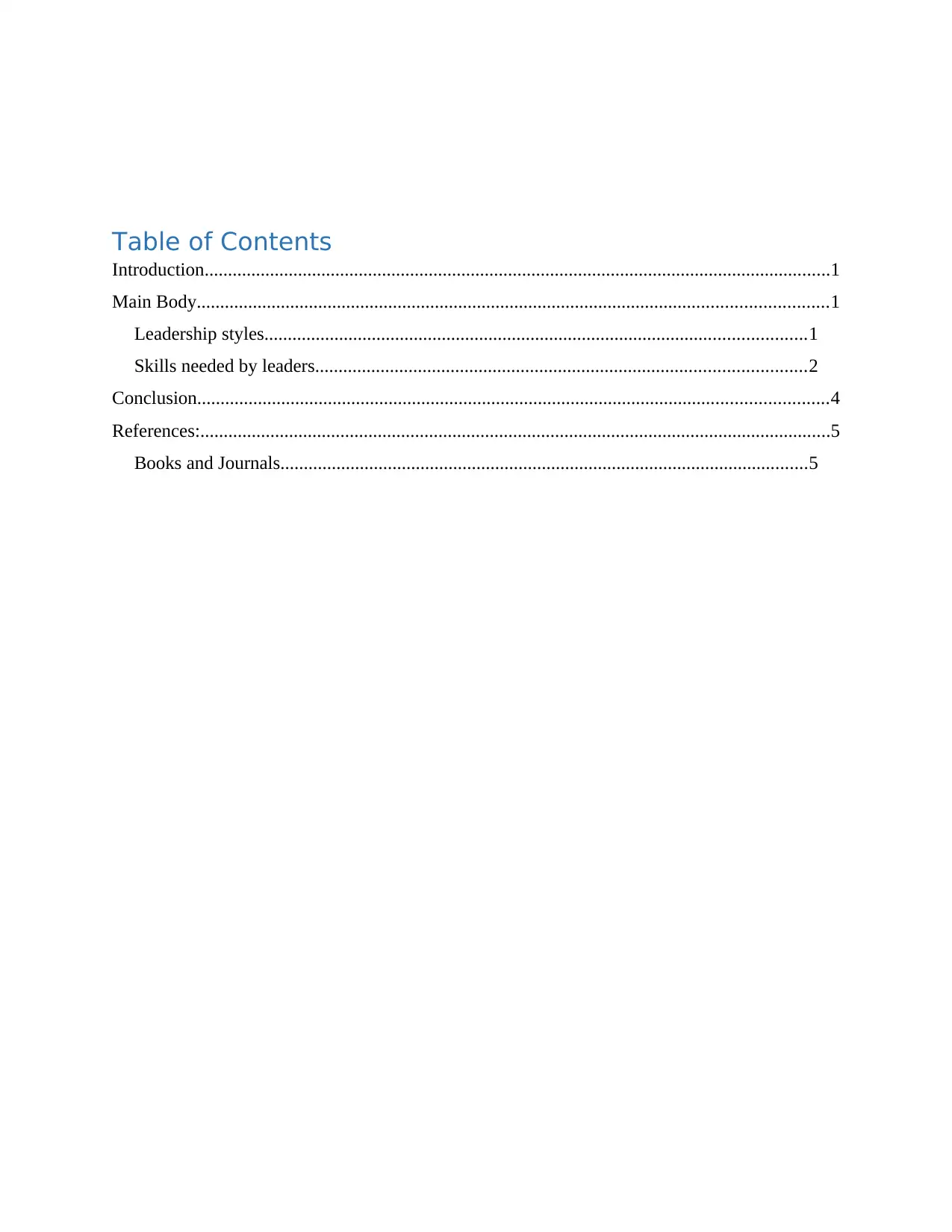
Table of Contents
Introduction......................................................................................................................................1
Main Body.......................................................................................................................................1
Leadership styles....................................................................................................................1
Skills needed by leaders.........................................................................................................2
Conclusion.......................................................................................................................................4
References:.......................................................................................................................................5
Books and Journals.................................................................................................................5
Introduction......................................................................................................................................1
Main Body.......................................................................................................................................1
Leadership styles....................................................................................................................1
Skills needed by leaders.........................................................................................................2
Conclusion.......................................................................................................................................4
References:.......................................................................................................................................5
Books and Journals.................................................................................................................5
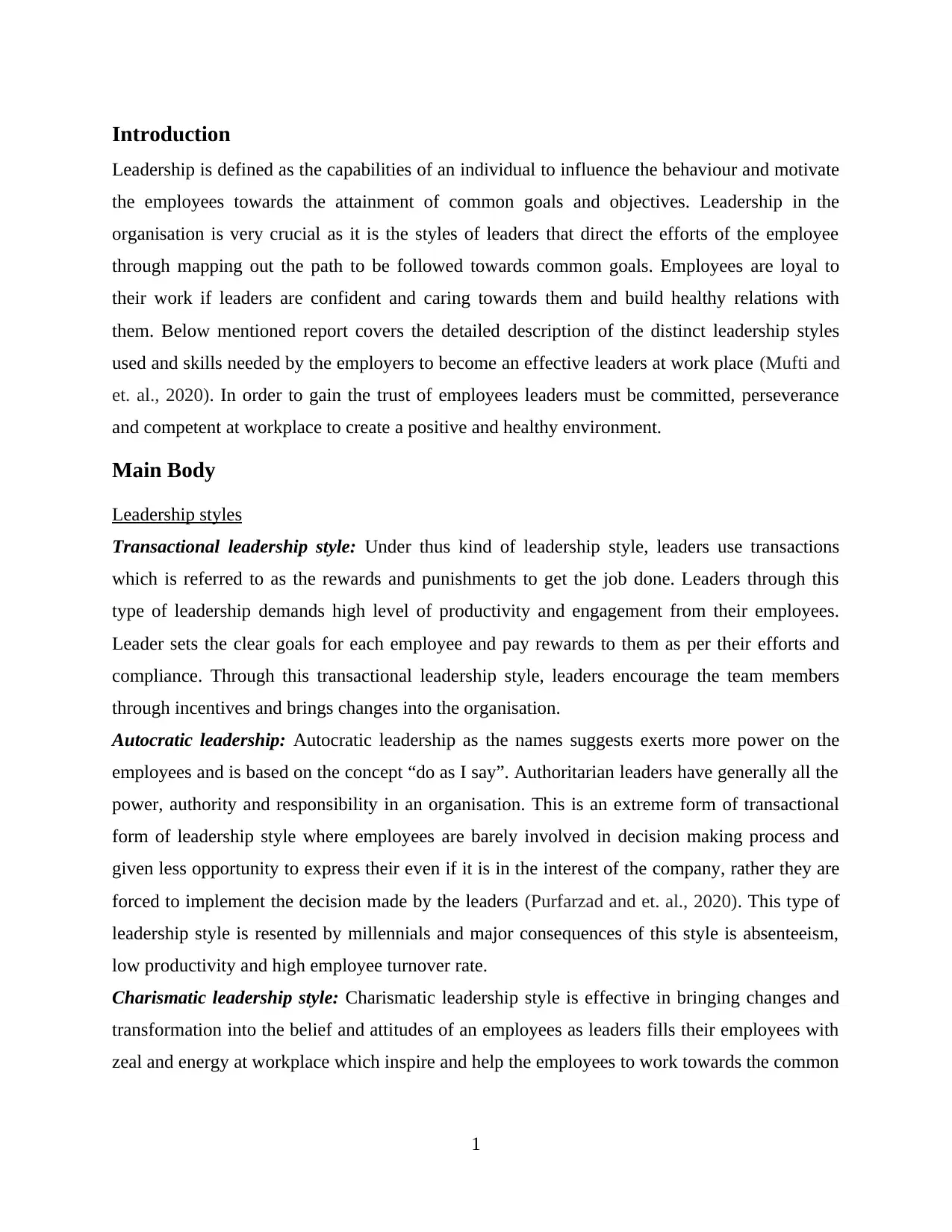
Introduction
Leadership is defined as the capabilities of an individual to influence the behaviour and motivate
the employees towards the attainment of common goals and objectives. Leadership in the
organisation is very crucial as it is the styles of leaders that direct the efforts of the employee
through mapping out the path to be followed towards common goals. Employees are loyal to
their work if leaders are confident and caring towards them and build healthy relations with
them. Below mentioned report covers the detailed description of the distinct leadership styles
used and skills needed by the employers to become an effective leaders at work place (Mufti and
et. al., 2020). In order to gain the trust of employees leaders must be committed, perseverance
and competent at workplace to create a positive and healthy environment.
Main Body
Leadership styles
Transactional leadership style: Under thus kind of leadership style, leaders use transactions
which is referred to as the rewards and punishments to get the job done. Leaders through this
type of leadership demands high level of productivity and engagement from their employees.
Leader sets the clear goals for each employee and pay rewards to them as per their efforts and
compliance. Through this transactional leadership style, leaders encourage the team members
through incentives and brings changes into the organisation.
Autocratic leadership: Autocratic leadership as the names suggests exerts more power on the
employees and is based on the concept “do as I say”. Authoritarian leaders have generally all the
power, authority and responsibility in an organisation. This is an extreme form of transactional
form of leadership style where employees are barely involved in decision making process and
given less opportunity to express their even if it is in the interest of the company, rather they are
forced to implement the decision made by the leaders (Purfarzad and et. al., 2020). This type of
leadership style is resented by millennials and major consequences of this style is absenteeism,
low productivity and high employee turnover rate.
Charismatic leadership style: Charismatic leadership style is effective in bringing changes and
transformation into the belief and attitudes of an employees as leaders fills their employees with
zeal and energy at workplace which inspire and help the employees to work towards the common
1
Leadership is defined as the capabilities of an individual to influence the behaviour and motivate
the employees towards the attainment of common goals and objectives. Leadership in the
organisation is very crucial as it is the styles of leaders that direct the efforts of the employee
through mapping out the path to be followed towards common goals. Employees are loyal to
their work if leaders are confident and caring towards them and build healthy relations with
them. Below mentioned report covers the detailed description of the distinct leadership styles
used and skills needed by the employers to become an effective leaders at work place (Mufti and
et. al., 2020). In order to gain the trust of employees leaders must be committed, perseverance
and competent at workplace to create a positive and healthy environment.
Main Body
Leadership styles
Transactional leadership style: Under thus kind of leadership style, leaders use transactions
which is referred to as the rewards and punishments to get the job done. Leaders through this
type of leadership demands high level of productivity and engagement from their employees.
Leader sets the clear goals for each employee and pay rewards to them as per their efforts and
compliance. Through this transactional leadership style, leaders encourage the team members
through incentives and brings changes into the organisation.
Autocratic leadership: Autocratic leadership as the names suggests exerts more power on the
employees and is based on the concept “do as I say”. Authoritarian leaders have generally all the
power, authority and responsibility in an organisation. This is an extreme form of transactional
form of leadership style where employees are barely involved in decision making process and
given less opportunity to express their even if it is in the interest of the company, rather they are
forced to implement the decision made by the leaders (Purfarzad and et. al., 2020). This type of
leadership style is resented by millennials and major consequences of this style is absenteeism,
low productivity and high employee turnover rate.
Charismatic leadership style: Charismatic leadership style is effective in bringing changes and
transformation into the belief and attitudes of an employees as leaders fills their employees with
zeal and energy at workplace which inspire and help the employees to work towards the common
1
⊘ This is a preview!⊘
Do you want full access?
Subscribe today to unlock all pages.

Trusted by 1+ million students worldwide
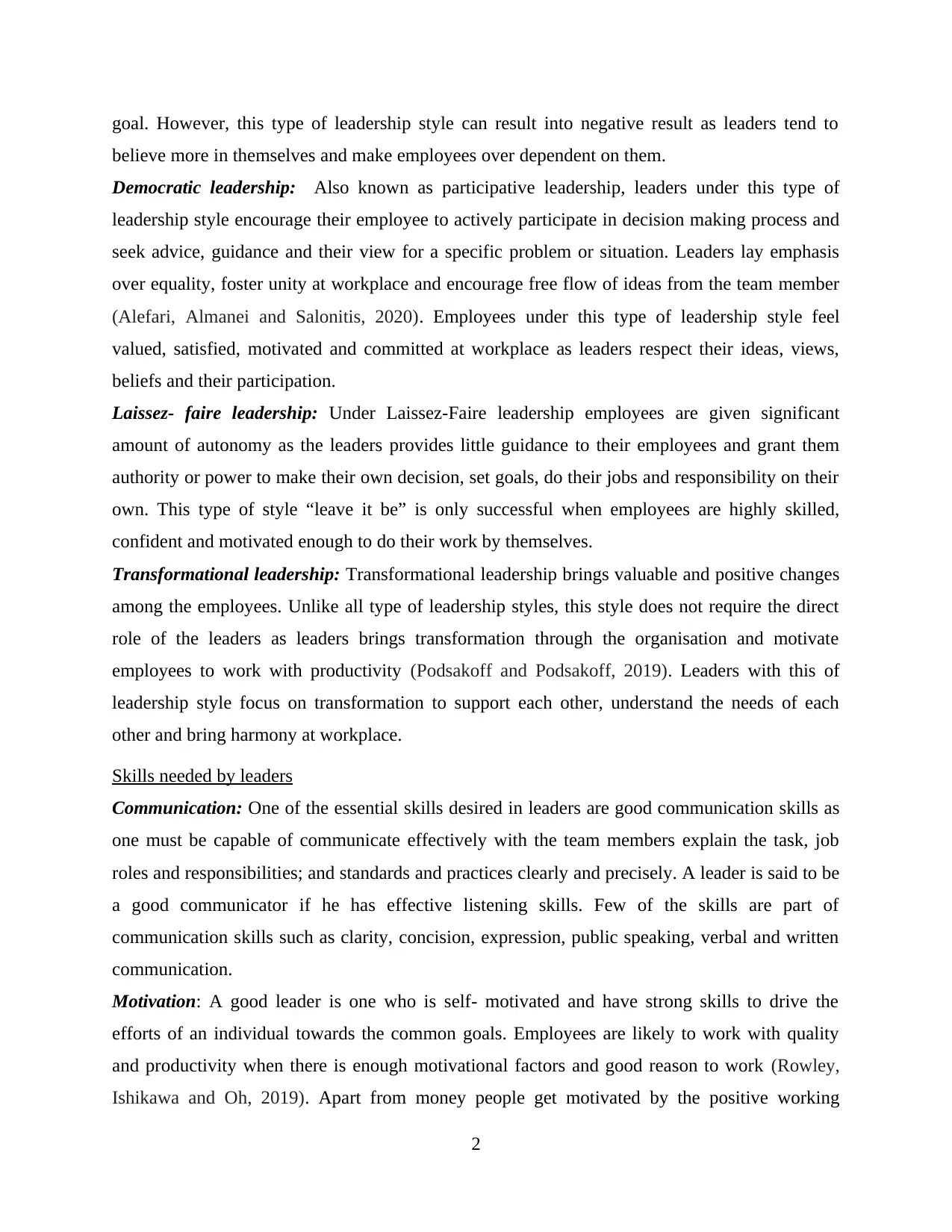
goal. However, this type of leadership style can result into negative result as leaders tend to
believe more in themselves and make employees over dependent on them.
Democratic leadership: Also known as participative leadership, leaders under this type of
leadership style encourage their employee to actively participate in decision making process and
seek advice, guidance and their view for a specific problem or situation. Leaders lay emphasis
over equality, foster unity at workplace and encourage free flow of ideas from the team member
(Alefari, Almanei and Salonitis, 2020). Employees under this type of leadership style feel
valued, satisfied, motivated and committed at workplace as leaders respect their ideas, views,
beliefs and their participation.
Laissez- faire leadership: Under Laissez-Faire leadership employees are given significant
amount of autonomy as the leaders provides little guidance to their employees and grant them
authority or power to make their own decision, set goals, do their jobs and responsibility on their
own. This type of style “leave it be” is only successful when employees are highly skilled,
confident and motivated enough to do their work by themselves.
Transformational leadership: Transformational leadership brings valuable and positive changes
among the employees. Unlike all type of leadership styles, this style does not require the direct
role of the leaders as leaders brings transformation through the organisation and motivate
employees to work with productivity (Podsakoff and Podsakoff, 2019). Leaders with this of
leadership style focus on transformation to support each other, understand the needs of each
other and bring harmony at workplace.
Skills needed by leaders
Communication: One of the essential skills desired in leaders are good communication skills as
one must be capable of communicate effectively with the team members explain the task, job
roles and responsibilities; and standards and practices clearly and precisely. A leader is said to be
a good communicator if he has effective listening skills. Few of the skills are part of
communication skills such as clarity, concision, expression, public speaking, verbal and written
communication.
Motivation: A good leader is one who is self- motivated and have strong skills to drive the
efforts of an individual towards the common goals. Employees are likely to work with quality
and productivity when there is enough motivational factors and good reason to work (Rowley,
Ishikawa and Oh, 2019). Apart from money people get motivated by the positive working
2
believe more in themselves and make employees over dependent on them.
Democratic leadership: Also known as participative leadership, leaders under this type of
leadership style encourage their employee to actively participate in decision making process and
seek advice, guidance and their view for a specific problem or situation. Leaders lay emphasis
over equality, foster unity at workplace and encourage free flow of ideas from the team member
(Alefari, Almanei and Salonitis, 2020). Employees under this type of leadership style feel
valued, satisfied, motivated and committed at workplace as leaders respect their ideas, views,
beliefs and their participation.
Laissez- faire leadership: Under Laissez-Faire leadership employees are given significant
amount of autonomy as the leaders provides little guidance to their employees and grant them
authority or power to make their own decision, set goals, do their jobs and responsibility on their
own. This type of style “leave it be” is only successful when employees are highly skilled,
confident and motivated enough to do their work by themselves.
Transformational leadership: Transformational leadership brings valuable and positive changes
among the employees. Unlike all type of leadership styles, this style does not require the direct
role of the leaders as leaders brings transformation through the organisation and motivate
employees to work with productivity (Podsakoff and Podsakoff, 2019). Leaders with this of
leadership style focus on transformation to support each other, understand the needs of each
other and bring harmony at workplace.
Skills needed by leaders
Communication: One of the essential skills desired in leaders are good communication skills as
one must be capable of communicate effectively with the team members explain the task, job
roles and responsibilities; and standards and practices clearly and precisely. A leader is said to be
a good communicator if he has effective listening skills. Few of the skills are part of
communication skills such as clarity, concision, expression, public speaking, verbal and written
communication.
Motivation: A good leader is one who is self- motivated and have strong skills to drive the
efforts of an individual towards the common goals. Employees are likely to work with quality
and productivity when there is enough motivational factors and good reason to work (Rowley,
Ishikawa and Oh, 2019). Apart from money people get motivated by the positive working
2
Paraphrase This Document
Need a fresh take? Get an instant paraphrase of this document with our AI Paraphraser
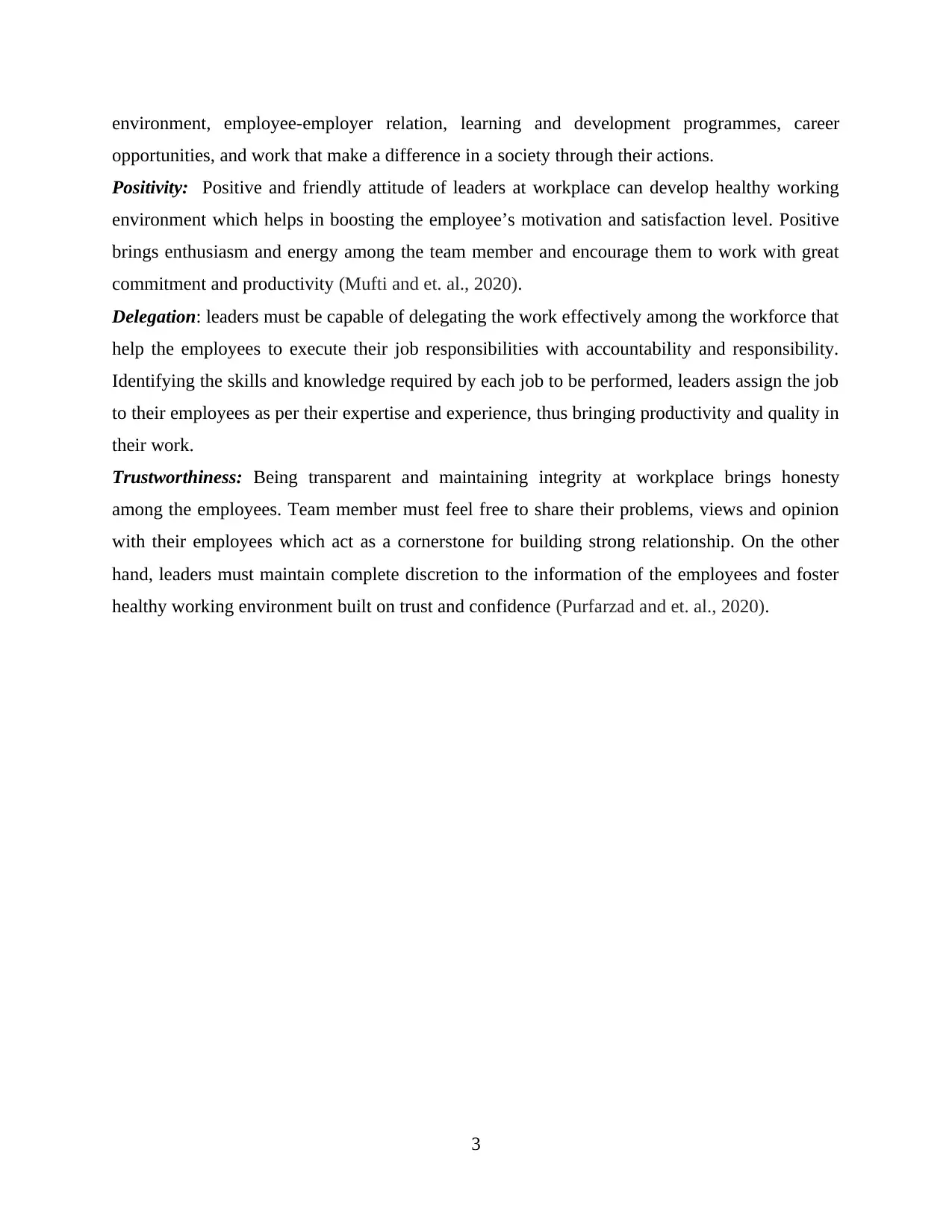
environment, employee-employer relation, learning and development programmes, career
opportunities, and work that make a difference in a society through their actions.
Positivity: Positive and friendly attitude of leaders at workplace can develop healthy working
environment which helps in boosting the employee’s motivation and satisfaction level. Positive
brings enthusiasm and energy among the team member and encourage them to work with great
commitment and productivity (Mufti and et. al., 2020).
Delegation: leaders must be capable of delegating the work effectively among the workforce that
help the employees to execute their job responsibilities with accountability and responsibility.
Identifying the skills and knowledge required by each job to be performed, leaders assign the job
to their employees as per their expertise and experience, thus bringing productivity and quality in
their work.
Trustworthiness: Being transparent and maintaining integrity at workplace brings honesty
among the employees. Team member must feel free to share their problems, views and opinion
with their employees which act as a cornerstone for building strong relationship. On the other
hand, leaders must maintain complete discretion to the information of the employees and foster
healthy working environment built on trust and confidence (Purfarzad and et. al., 2020).
3
opportunities, and work that make a difference in a society through their actions.
Positivity: Positive and friendly attitude of leaders at workplace can develop healthy working
environment which helps in boosting the employee’s motivation and satisfaction level. Positive
brings enthusiasm and energy among the team member and encourage them to work with great
commitment and productivity (Mufti and et. al., 2020).
Delegation: leaders must be capable of delegating the work effectively among the workforce that
help the employees to execute their job responsibilities with accountability and responsibility.
Identifying the skills and knowledge required by each job to be performed, leaders assign the job
to their employees as per their expertise and experience, thus bringing productivity and quality in
their work.
Trustworthiness: Being transparent and maintaining integrity at workplace brings honesty
among the employees. Team member must feel free to share their problems, views and opinion
with their employees which act as a cornerstone for building strong relationship. On the other
hand, leaders must maintain complete discretion to the information of the employees and foster
healthy working environment built on trust and confidence (Purfarzad and et. al., 2020).
3
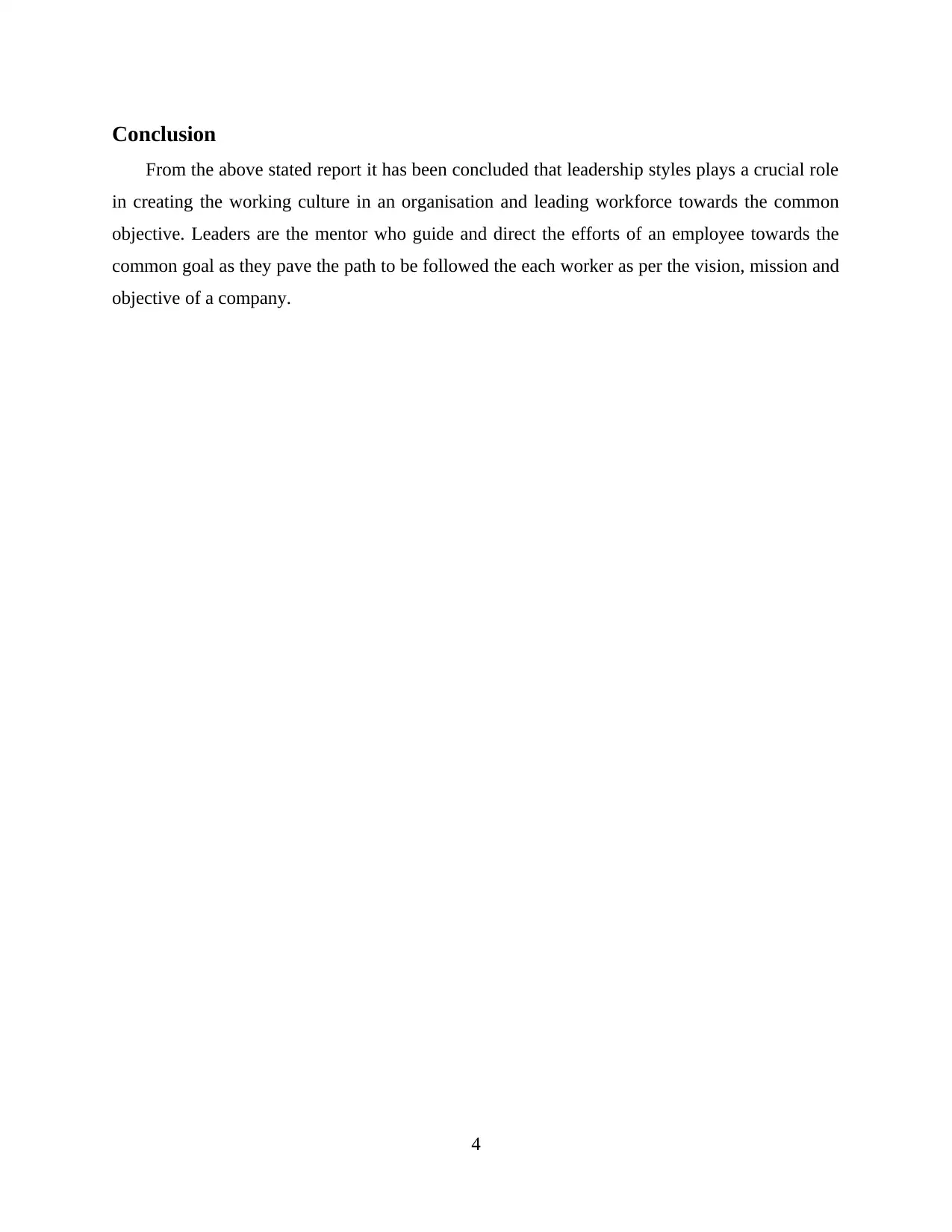
Conclusion
From the above stated report it has been concluded that leadership styles plays a crucial role
in creating the working culture in an organisation and leading workforce towards the common
objective. Leaders are the mentor who guide and direct the efforts of an employee towards the
common goal as they pave the path to be followed the each worker as per the vision, mission and
objective of a company.
4
From the above stated report it has been concluded that leadership styles plays a crucial role
in creating the working culture in an organisation and leading workforce towards the common
objective. Leaders are the mentor who guide and direct the efforts of an employee towards the
common goal as they pave the path to be followed the each worker as per the vision, mission and
objective of a company.
4
⊘ This is a preview!⊘
Do you want full access?
Subscribe today to unlock all pages.

Trusted by 1+ million students worldwide
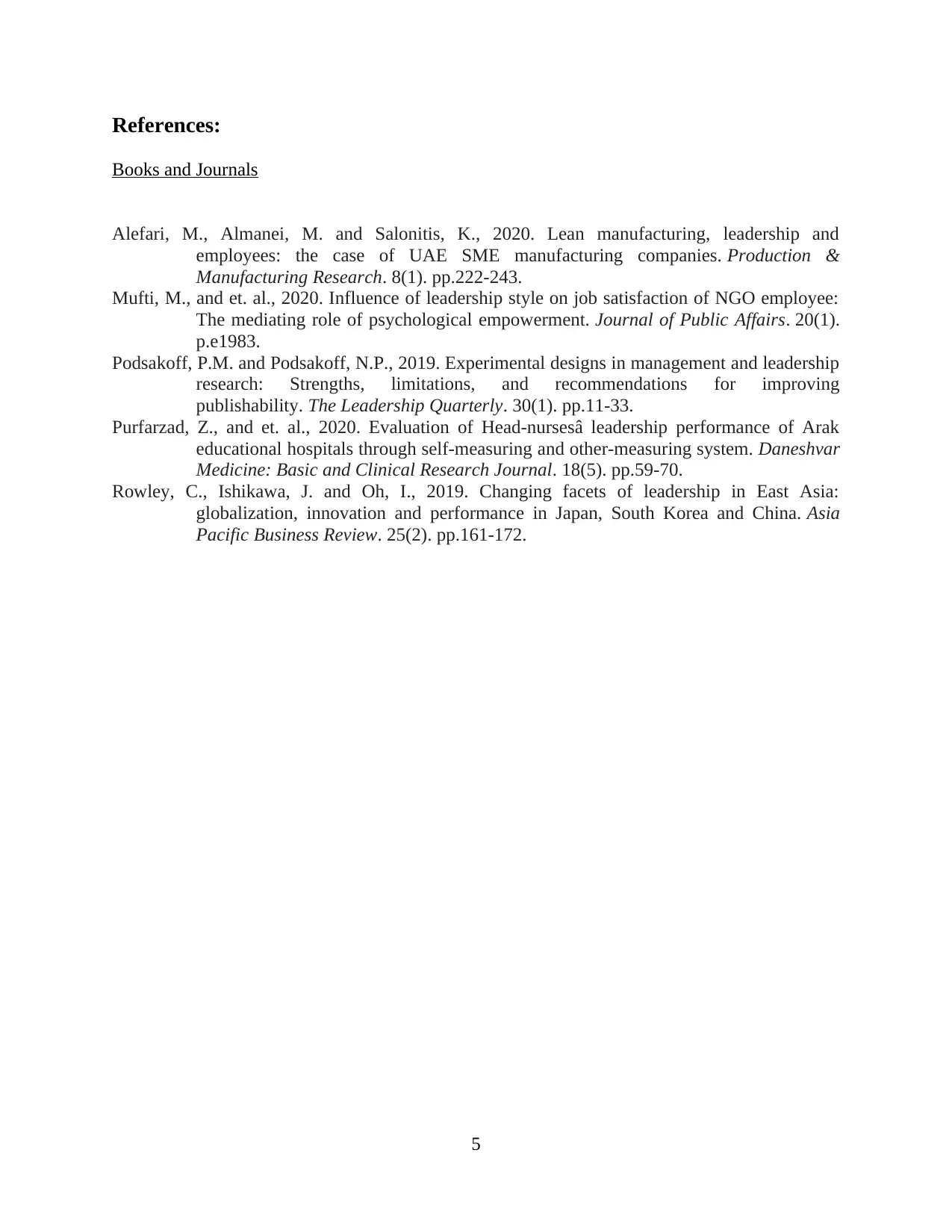
References:
Books and Journals
Alefari, M., Almanei, M. and Salonitis, K., 2020. Lean manufacturing, leadership and
employees: the case of UAE SME manufacturing companies. Production &
Manufacturing Research. 8(1). pp.222-243.
Mufti, M., and et. al., 2020. Influence of leadership style on job satisfaction of NGO employee:
The mediating role of psychological empowerment. Journal of Public Affairs. 20(1).
p.e1983.
Podsakoff, P.M. and Podsakoff, N.P., 2019. Experimental designs in management and leadership
research: Strengths, limitations, and recommendations for improving
publishability. The Leadership Quarterly. 30(1). pp.11-33.
Purfarzad, Z., and et. al., 2020. Evaluation of Head-nursesâ leadership performance of Arak
educational hospitals through self-measuring and other-measuring system. Daneshvar
Medicine: Basic and Clinical Research Journal. 18(5). pp.59-70.
Rowley, C., Ishikawa, J. and Oh, I., 2019. Changing facets of leadership in East Asia:
globalization, innovation and performance in Japan, South Korea and China. Asia
Pacific Business Review. 25(2). pp.161-172.
5
Books and Journals
Alefari, M., Almanei, M. and Salonitis, K., 2020. Lean manufacturing, leadership and
employees: the case of UAE SME manufacturing companies. Production &
Manufacturing Research. 8(1). pp.222-243.
Mufti, M., and et. al., 2020. Influence of leadership style on job satisfaction of NGO employee:
The mediating role of psychological empowerment. Journal of Public Affairs. 20(1).
p.e1983.
Podsakoff, P.M. and Podsakoff, N.P., 2019. Experimental designs in management and leadership
research: Strengths, limitations, and recommendations for improving
publishability. The Leadership Quarterly. 30(1). pp.11-33.
Purfarzad, Z., and et. al., 2020. Evaluation of Head-nursesâ leadership performance of Arak
educational hospitals through self-measuring and other-measuring system. Daneshvar
Medicine: Basic and Clinical Research Journal. 18(5). pp.59-70.
Rowley, C., Ishikawa, J. and Oh, I., 2019. Changing facets of leadership in East Asia:
globalization, innovation and performance in Japan, South Korea and China. Asia
Pacific Business Review. 25(2). pp.161-172.
5
1 out of 7
Related Documents
Your All-in-One AI-Powered Toolkit for Academic Success.
+13062052269
info@desklib.com
Available 24*7 on WhatsApp / Email
![[object Object]](/_next/static/media/star-bottom.7253800d.svg)
Unlock your academic potential
Copyright © 2020–2025 A2Z Services. All Rights Reserved. Developed and managed by ZUCOL.




